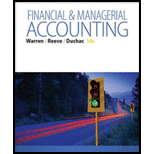
Financial & Managerial Accounting
13th Edition
ISBN: 9781285866307
Author: Carl Warren, James M. Reeve, Jonathan Duchac
Publisher: Cengage Learning
expand_more
expand_more
format_list_bulleted
Concept explainers
Question
Chapter 6, Problem 6.8EX
To determine
Perpetual Inventory System:
Perpetual Inventory System refers to the inventory system that maintains the detailed records of every inventory transactions related to purchases, and sales on a continuous basis. It shows the exact on-hand-inventory at any point of time.
Weighted -average cost method:
Under weighted average cost method, the company calculates a new average cost after every purchase is made. It is determined by dividing the cost of goods available for sale by the units on hand.
cost of merchandise sold for each sale after each sale as on October 31.
Expert Solution & Answer
Trending nowThis is a popular solution!

Students have asked these similar questions
None
Not need ai solution please solve this general accounting question
Financial accounting
Chapter 6 Solutions
Financial & Managerial Accounting
Ch. 6 - Before inventory purchases are recorded, the...Ch. 6 - Why is it important to periodically take a...Ch. 6 - Do the terms FIFO, LIFO, and weighted average...Ch. 6 - If inventory is being valued at cost and the price...Ch. 6 - Which of the three methods of inventory...Ch. 6 - If inventory is being valued at cost and the price...Ch. 6 - Using the following data, how should the inventory...Ch. 6 - Prob. 8DQCh. 6 - Hutch Co. sold merchandise to Bibbins Company on...Ch. 6 - A manufacturer shipped merchandise to a retailer...
Ch. 6 - Prob. 6.1APECh. 6 - Prob. 6.1BPECh. 6 - Perpetual inventory using FIFO Beginning...Ch. 6 - Perpetual inventory using FIFO Beginning...Ch. 6 - Perpetual inventory using UFO Beginning inventory,...Ch. 6 - Perpetual inventory using LIFO Beginning...Ch. 6 - Perpetual inventory using weighted average...Ch. 6 - Perpetual inventory using weighted average...Ch. 6 - Periodic inventory using FIFO, LIFO, and weighted...Ch. 6 - Periodic inventory using FIFO, UFO, and weighted...Ch. 6 - Prob. 6.6APECh. 6 - Lower-of-cost-or-market method On the basis of the...Ch. 6 - Prob. 6.7APECh. 6 - Prob. 6.7BPECh. 6 - Inventory turnover and number of days' sales in...Ch. 6 - Inventory turnover and number of days' sales in...Ch. 6 - Control of inventories Triple Creek Hardware Store...Ch. 6 - Prob. 6.2EXCh. 6 - Perpetual inventory using FIFO Beginning...Ch. 6 - Perpetual inventory using LIFO Assume that the...Ch. 6 - Perpetual inventory using LIFO Beginning...Ch. 6 - Perpetual inventory using FIFO Assume that the...Ch. 6 - FIFO and LIFO costs under perpetual Inventory...Ch. 6 - Prob. 6.8EXCh. 6 - Prob. 6.9EXCh. 6 - Prob. 6.10EXCh. 6 - Prob. 6.11EXCh. 6 - Prob. 6.12EXCh. 6 - Periodic inventory by three methods; cost of...Ch. 6 - Comparing inventory methods Assume that a firm...Ch. 6 - Lower of cost or market inventory On the basis of...Ch. 6 - Merchandise inventory on the balance sheet Based...Ch. 6 - Effect of errors in physical inventory Missouri...Ch. 6 - Effect of errors in physical inventory Fonda...Ch. 6 - Prob. 6.19EXCh. 6 - Prob. 6.20EXCh. 6 - Prob. 6.21EXCh. 6 - Prob. 6.22EXCh. 6 - Retail method A business using the retail method...Ch. 6 - Retail method A business using the retail method...Ch. 6 - Retail method On the basis of the following data,...Ch. 6 - Gross profit method The inventory was destroyed by...Ch. 6 - Prob. 6.27EXCh. 6 - Gross profit method Based on the following data,...Ch. 6 - FIFO perpetual inventory The beginning inventory...Ch. 6 - Prob. 6.2APRCh. 6 - Prob. 6.3APRCh. 6 - Prob. 6.4APRCh. 6 - Prob. 6.5APRCh. 6 - Prob. 6.6APRCh. 6 - Prob. 6.7APRCh. 6 - FIFO perpetual inventory The beginning inventory...Ch. 6 - Prob. 6.2BPRCh. 6 - Weighted average cost method with perpetual...Ch. 6 - Prob. 6.4BPRCh. 6 - Prob. 6.5BPRCh. 6 - Prob. 6.6BPRCh. 6 - Retail method; gross project method Selected data...Ch. 6 - Prob. 6.1CPCh. 6 - Prob. 6.2CPCh. 6 - Costing inventory Golden Eagle Company begun...Ch. 6 - Inventory ratios for Dell and HP Dell Inc. and...Ch. 6 - Prob. 6.5CPCh. 6 - Prob. 6.6CP
Knowledge Booster
Learn more about
Need a deep-dive on the concept behind this application? Look no further. Learn more about this topic, accounting and related others by exploring similar questions and additional content below.Similar questions
arrow_back_ios
SEE MORE QUESTIONS
arrow_forward_ios
Recommended textbooks for you
- Principles of Accounting Volume 1AccountingISBN:9781947172685Author:OpenStaxPublisher:OpenStax College
 Cornerstones of Financial AccountingAccountingISBN:9781337690881Author:Jay Rich, Jeff JonesPublisher:Cengage Learning
Cornerstones of Financial AccountingAccountingISBN:9781337690881Author:Jay Rich, Jeff JonesPublisher:Cengage Learning Financial Accounting: The Impact on Decision Make...AccountingISBN:9781305654174Author:Gary A. Porter, Curtis L. NortonPublisher:Cengage Learning
Financial Accounting: The Impact on Decision Make...AccountingISBN:9781305654174Author:Gary A. Porter, Curtis L. NortonPublisher:Cengage Learning  Intermediate Accounting: Reporting And AnalysisAccountingISBN:9781337788281Author:James M. Wahlen, Jefferson P. Jones, Donald PagachPublisher:Cengage Learning
Intermediate Accounting: Reporting And AnalysisAccountingISBN:9781337788281Author:James M. Wahlen, Jefferson P. Jones, Donald PagachPublisher:Cengage Learning College Accounting, Chapters 1-27AccountingISBN:9781337794756Author:HEINTZ, James A.Publisher:Cengage Learning,
College Accounting, Chapters 1-27AccountingISBN:9781337794756Author:HEINTZ, James A.Publisher:Cengage Learning, Financial AccountingAccountingISBN:9781305088436Author:Carl Warren, Jim Reeve, Jonathan DuchacPublisher:Cengage Learning
Financial AccountingAccountingISBN:9781305088436Author:Carl Warren, Jim Reeve, Jonathan DuchacPublisher:Cengage Learning

Principles of Accounting Volume 1
Accounting
ISBN:9781947172685
Author:OpenStax
Publisher:OpenStax College

Cornerstones of Financial Accounting
Accounting
ISBN:9781337690881
Author:Jay Rich, Jeff Jones
Publisher:Cengage Learning

Financial Accounting: The Impact on Decision Make...
Accounting
ISBN:9781305654174
Author:Gary A. Porter, Curtis L. Norton
Publisher:Cengage Learning

Intermediate Accounting: Reporting And Analysis
Accounting
ISBN:9781337788281
Author:James M. Wahlen, Jefferson P. Jones, Donald Pagach
Publisher:Cengage Learning

College Accounting, Chapters 1-27
Accounting
ISBN:9781337794756
Author:HEINTZ, James A.
Publisher:Cengage Learning,

Financial Accounting
Accounting
ISBN:9781305088436
Author:Carl Warren, Jim Reeve, Jonathan Duchac
Publisher:Cengage Learning
Chapter 6 Merchandise Inventory; Author: Vicki Stewart;https://www.youtube.com/watch?v=DnrcQLD2yKU;License: Standard YouTube License, CC-BY
Accounting for Merchandising Operations Recording Purchases of Merchandise; Author: Socrat Ghadban;https://www.youtube.com/watch?v=iQp5UoYpG20;License: Standard Youtube License